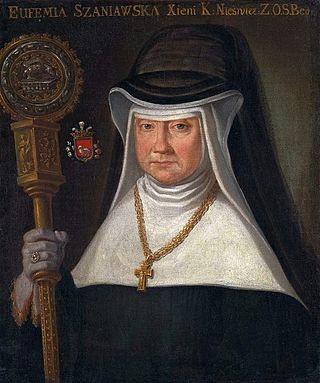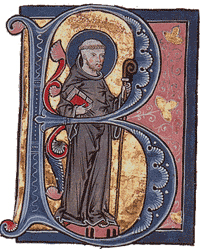
An abbess is the female superior of a community of nuns in an abbey.

An abbey is a type of monastery used by members of a religious order under the governance of an abbot or abbess. Abbeys provide a complex of buildings and land for religious activities, work, and housing of Christian monks and nuns.

A nun is a woman who vows to dedicate her life to religious service and contemplation, typically living under vows of poverty, chastity, and obedience in the enclosure of a monastery or convent. The term is often used interchangeably with religious sisters who do take simple vows but live an active vocation of prayer and charitable work.
A religious order is a lineage of communities and organizations of people who live in some way set apart from society in accordance with their specific religious devotion, usually characterized by the principles of its founder's religious practice. It is usually composed of laypeople and, in some orders, clergy. Such orders exist in many of the world's religions.

A monk is a person who practices religious asceticism by living a monastic lifestyle, either alone or with any number of other monks. A monk may be a person who decides to dedicate his life to serving other people and serving God, or to be an ascetic who voluntarily chooses to leave mainstream society and live his life in prayer and contemplation. The concept is ancient and can be seen in many religions and in philosophy.

Christian monasticism is the devotional practice of Christians who live ascetic and typically cloistered lives that are dedicated to Christian worship. It began to develop early in the history of the Christian Church, modeled upon scriptural examples and ideals, including those in the Old Testament. It has come to be regulated by religious rules and, in modern times, the Canon law of the respective Christian denominations that have forms of monastic living. Those living the monastic life are known by the generic terms monks (men) and nuns (women). The word monk originated from the Greek μοναχός, itself from μόνος meaning 'alone'.
Canons regular are priests who live in community under a rule and are generally organised into religious orders, differing from both secular canons and other forms of religious life, such as clerics regular, designated by a partly similar terminology.

The Catholic Church in Israel is part of the worldwide Catholic Church, in full communion with the Holy See in Rome. The Catholic Church in Israel is divided into three main jurisdictions: the Latin Patriarchate of Jerusalem, the Franciscan Custody of the Holy Land, and the Salesian Mission. Each of these jurisdictions has its own responsibilities and areas of operation.

Anglican religious orders are communities of men or women in the Anglican Communion who live under a common rule of life. The members of religious orders take vows which often include the traditional monastic vows of poverty, chastity and obedience, or the ancient vow of stability, or sometimes a modern interpretation of some or all of these vows. Members may be laity or clergy, but most commonly include a mixture of both. They lead a common life of work and prayer, sometimes on a single site, sometimes spread over multiple locations. Though many Anglicans are members of religious orders recognized by the Anglican Communion, others may be members of ecumenical Protestant or Old Catholic religious orders while maintaining their Anglican identity and parochial membership in Anglican churches.
The Order of the Holy Cross is an international Anglican monastic order that follows the Rule of St. Benedict.

There are a number of Benedictine Anglican religious orders, some of them using the name Order of St. Benedict (OSB). Just like their Roman Catholic counterparts, each abbey/priory/convent is independent of each other. The vows are not made to an order, but to a local incarnation of the order, hence each individual order is free to develop its own character and charism, yet each under a common rule of life after the precepts of St. Benedict. Most of the communities include a confraternity of oblates. The order consists of a number of independent communities.
Order of the Holy Cross refers to several institutions by that name:
Aelred Carlyle OSB founded, around 1895, the first regularised Anglican Benedictine community of monks.
A religious brother is a member of a religious institute or religious order who commits himself to following Christ in consecrated life of the Church, usually by the vows of poverty, chastity and obedience. He is usually a layman and usually lives in a religious community and works in a ministry appropriate to his capabilities.
This is a glossary of terms used within the Catholic Church. Some terms used in everyday English have a different meaning in the context of the Catholic faith, including brother, confession, confirmation, exemption, faithful, father, ordinary, religious, sister, venerable, and vow.

Anglican Cistercians are members of the Anglican Communion who live a common life together according to the Cistercian tradition. This tradition is usually dated to 1098 in origin. The term Cistercian is derived from Cistercium, the Latin name for the village of Cîteaux, near Dijon in eastern France. It was in this village that a group of Benedictine monks from the monastery of Molesme founded Cîteaux Abbey in 1098, with the goal of following more closely the Rule of Saint Benedict. Monks following this rule are known as Benedictine, and were at that time the dominant force in Christian monasticism. The monks of Cîteaux Abbey effectively founded a new order, but one that remains closely associated with the Benedictine Order. As a mark of their distinctive charism and rule, Cistercian monks have long worn white habits to distinguish themselves from Benedictine monks who wear black habits. Within Anglicanism there has historically been less interest in the Cistercian Order than certain other monastic Rules, although Cistercian life has been represented continuously in the Church of England since at least 1966.

William Henry Francis, also William Henry Francis Brothers with his matronymic surname added, was an Old Catholic Benedictine, advocate for the immigrant, worker and the poor.
Augustinian nuns are named after Saint Augustine of Hippo and exist in the Roman Catholic and Anglican churches. In the Roman Catholic Church there are both enclosed monastic orders of women living according to a guide to religious life known as the Rule of St Augustine, and also other independent Augustinian congregations living in the spirit of this rule. In the Anglican Communion, there is no single "Order of St Augustine", but a number of Augustinian congregations of sisters living according to the Rule of St Augustine.









